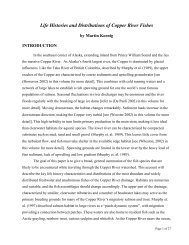Mitigation for the Construction and Operation of Libby Dam
Mitigation for the Construction and Operation of Libby Dam
Mitigation for the Construction and Operation of Libby Dam
Create successful ePaper yourself
Turn your PDF publications into a flip-book with our unique Google optimized e-Paper software.
Grave Creek Phase I Restoration Project<br />
Montana FWP entered into a cooperative agreement that was coordinated through <strong>the</strong><br />
Kootenai River Network to retain a consultant to develop <strong>and</strong> implement a restoration plan<br />
<strong>for</strong> approximately 4,300 feet <strong>of</strong> channel within <strong>the</strong> lower three miles <strong>of</strong> Grave Creek (WCI<br />
2002). Additional contributors to <strong>the</strong> project included Montana Department <strong>of</strong><br />
Environmental Quality, <strong>the</strong> National Fish <strong>and</strong> Wildlife Foundation, <strong>the</strong> Steele-Reese<br />
Foundation, <strong>the</strong> U.S. Fish <strong>and</strong> Wildlife Service (Partners <strong>for</strong> Wildlife Program), <strong>the</strong> Montana<br />
Community Foundation, <strong>the</strong> Montana Trout Foundation, <strong>and</strong> <strong>the</strong> Cadeau Foundation. The<br />
project is termed <strong>the</strong> Grave Creek Phase I Restoration Project, <strong>and</strong> begins at <strong>the</strong> downstream<br />
end <strong>of</strong> <strong>the</strong> Grave Creek Demonstration Project (see Dunnigan et al. 2003). Project<br />
construction work began during <strong>the</strong> fall <strong>of</strong> 2002. The objectives <strong>of</strong> <strong>the</strong> project were to: 1)<br />
Reduce <strong>the</strong> sediment sources <strong>and</strong> bank erosion throughout <strong>the</strong> project area by incorporating<br />
stabilization techniques that function naturally with <strong>the</strong> stream <strong>and</strong> which decrease <strong>the</strong><br />
amount <strong>of</strong> stress on <strong>the</strong> stream banks, 2) Convert <strong>the</strong> channelized portions <strong>of</strong> stream into a<br />
channel type that is self maintaining <strong>and</strong> will accommodate floods without major changes in<br />
channel pattern or pr<strong>of</strong>ile, 3) Use natural stream stabilization techniques that will allow <strong>the</strong><br />
stream to adjust slowly over time <strong>and</strong> be representative <strong>of</strong> a natural stream system, 4)<br />
Improve fish habitat, particularly <strong>for</strong> bull trout, <strong>and</strong> improve <strong>the</strong> function <strong>and</strong> aes<strong>the</strong>tics <strong>of</strong><br />
<strong>the</strong> river <strong>and</strong> adjacent riparian ecosystem, <strong>and</strong> 5) Reduce <strong>the</strong> effects <strong>of</strong> flooding on adjacent<br />
l<strong>and</strong>owners.<br />
Stream restoration work began in September 2002 <strong>and</strong> proceeded through December<br />
2002. During that period numerous structures were installed to accomplish <strong>the</strong> above stated<br />
objectives. These structures included 12 rootwad composites, 11 debris jams, 8 log J-hook<br />
vanes, 4 cobble patches, 3 log cross vanes, 1 rock cross vane, 1 rock J-hook vane, 1 straight<br />
log vane, <strong>and</strong> 2.4 acres <strong>of</strong> sod transplants. The revegetation work was started in <strong>the</strong> fall <strong>of</strong><br />
2002, but due to unfavorable wea<strong>the</strong>r conditions, it was not completed until <strong>the</strong> spring <strong>of</strong><br />
2003, <strong>and</strong> is expected to serve as <strong>the</strong> primary stabilization mechanism in <strong>the</strong> long-term.<br />
Grave Creek Phase I Restoration Project area has been subjected to long-term urban<br />
encroachment, removal <strong>of</strong> riparian vegetation, <strong>and</strong> extensive channel manipulation. These<br />
activities have resulted in <strong>the</strong> substantial reduction in floodplain <strong>and</strong> streamside vegetation,<br />
<strong>and</strong> <strong>the</strong> alteration <strong>of</strong> lower Grave Creek’s natural dimension <strong>and</strong> me<strong>and</strong>er pattern.<br />
The Grave Creek Phase I Restoration Project changed <strong>the</strong> dimension, pattern <strong>and</strong><br />
longitudinal pr<strong>of</strong>ile within <strong>the</strong> project area, which were designed to achieve <strong>the</strong> long-term<br />
project objectives. Table 4 presents <strong>the</strong> existing <strong>and</strong> design criteria <strong>for</strong> some important<br />
geomorphical stream characteristics. We surveyed 6 permanent cross-sections located<br />
throughout <strong>the</strong> project area in 1999 (pre project), 2002 (post-construction) <strong>and</strong> 2003 (after<br />
<strong>the</strong> first spring freshet), <strong>and</strong> measured mean bankfull width, depth, cross sectional area,<br />
maximum depth, <strong>and</strong> width to depth ratio at each transect. We used a repeated measures<br />
analysis <strong>of</strong> variance <strong>and</strong> subsequent multiple comparisons to test <strong>for</strong> significant differences<br />
between years. Of <strong>the</strong> 5 parameters that we measured at each <strong>of</strong> <strong>the</strong> 6 transects, width to<br />
depth ratio changed <strong>the</strong> most as a result <strong>of</strong> project implementation compared to existing<br />
134
















